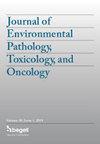Silencing the lncRNA EBLN3P alleviates poor prognosis in patients with invasive breast cancer by directly targeting miR-144-3p
IF 2.9
4区 医学
Q3 TOXICOLOGY
Journal of Environmental Pathology Toxicology and Oncology
Pub Date : 2024-04-01
DOI:10.1615/jenvironpatholtoxicoloncol.2024053299
引用次数: 0
Abstract
Background: The incidence of breast cancer, a malignant tumor that causes more harm to women, is increasing year by year, affecting women at a younger age. This paper describes the possible practical significance of EBLN3P in predicting the prognosis of invasive breast cancer. Methods: EBLN3P and miR-144-3p levels in tissues and cells were detected by real-time quantitative PCR (RT-qPCR). The association between EBLN3P expression and prognosis of invasive breast cancer was investigated using Cox multivariate regression and Kaplan-Meier curve. The growth efficacy of EBLN3P expression on invasive breast cancer cells was evaluated by Cell Counting kit-8 (CCK-8) method and Transwell method, and the mechanism of EBLN3P targeting miR-144-3p was further studied. Results: EBLN3P was elevated in invasive breast cancer, whereas survival rates were lower in patients with high EBLN3P level. EBLN3P directly targeted miR-144-3p to participate in the mechanism of invasive breast cancer, and EBLN3P knockdown had an inhibitory effect on tumor cells. Conclusion: Silencing EBLN3P inhibited the advancement of invasive breast cancer and was expected to be a promising therapeutic target for clinical intervention and prognosis.沉默lncRNA EBLN3P可通过直接靶向miR-144-3p减轻浸润性乳腺癌患者的不良预后
背景:乳腺癌是一种对女性危害较大的恶性肿瘤,其发病率逐年上升,且发病年龄呈年轻化趋势。本文介绍了 EBLN3P 在预测浸润性乳腺癌预后方面可能具有的实际意义:方法:采用实时定量 PCR(RT-qPCR)技术检测组织和细胞中的 EBLN3P 和 miR-144-3p。方法:采用实时定量 PCR(RT-qPCR)技术检测组织和细胞中 EBLN3P 和 miR-144-3p 的水平,并利用 Cox 多元回归和 Kaplan-Meier 曲线研究 EBLN3P 表达与浸润性乳腺癌预后的关系。采用细胞计数试剂盒-8(CCK-8)法和Transwell法评估了EBLN3P表达对浸润性乳腺癌细胞的生长效应,并进一步研究了EBLN3P靶向miR-144-3p的机制:结果:EBLN3P在浸润性乳腺癌中升高,而EBLN3P水平高的患者生存率较低。EBLN3P直接靶向miR-144-3p,参与浸润性乳腺癌的发病机制,EBLN3P敲除对肿瘤细胞有抑制作用:结论:沉默EBLN3P可抑制浸润性乳腺癌的进展,有望成为临床干预和预后评估的治疗靶点。
本文章由计算机程序翻译,如有差异,请以英文原文为准。
求助全文
约1分钟内获得全文
求助全文
来源期刊
CiteScore
3.80
自引率
0.00%
发文量
20
审稿时长
>12 weeks
期刊介绍:
The Journal of Environmental Pathology, Toxicology and Oncology publishes original research and reviews of factors and conditions that affect human and animal carcinogensis. Scientists in various fields of biological research, such as toxicologists, chemists, immunologists, pharmacologists, oncologists, pneumologists, and industrial technologists, will find this journal useful in their research on the interface between the environment, humans, and animals.

 求助内容:
求助内容: 应助结果提醒方式:
应助结果提醒方式:


